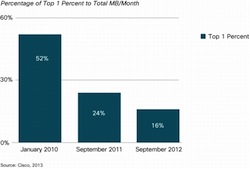
The whales don’t stand out as much anymore.
Three years ago, unlimited data plans accounted for 81% of monthly mobile subscriptions worldwide. Now, only 45% are unlimited, according to research conducted by Cisco.
With or without monthly caps, the growth in mobile data traffic is booming, but Cisco’s white papers shows a change in usage patterns corresponding to this business model shift.
Unlimited plans still generate more traffic per user, with an average of 1.3 GB per month versus 922 MB for tiered subscribers. As more people move to restricted plans, however, differences amongst users flatten out. The top one percent of mobile data customers accounted for 52% of global traffic three years ago, but now they only gobble up 16%. One of the primary goals of usage restrictions is to throttle back the heaviest of the heavy, and it seems to be working. Cisco’s research also pointed to efforts by carriers to soften the impact:
Mobile data caps that fall too far behind usage volumes may create opportunities for competitors in the market. Therefore, many service providers are creating more nuanced tiers and data add- ons, such as a separate charge for tethering and hotspot functionality.
Caps don’t keep people from using more data, though. Over three years, the amount of traffic generated by the average tiered plan customer grew 117%, going from 425 MB per month to 922 MB. Unlimited subscribers still chew up more data, going from an average of 738 MB to 1.3 GN per month, but it’s a slower rate of growth – 71%.
What that tells me is that heavy users are still willing to pay the premium for unlimited access when it’s available, but they’re shifting to plans with some degree of usage based pricing. When they do, they pay more attention, which shows up as a lower monthly average. But they’re still using more bandwidth than the sort of customers who have been on capped plans all along, which drives up the rate of growth.
Overall, it looks like mobile carriers are succeeding in matching subscriber revenue more closely to the cost of providing services.
